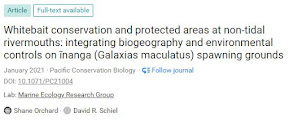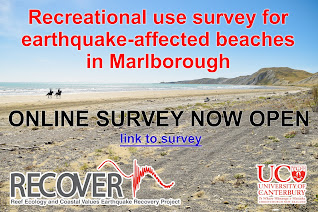In this paper recent published in GeoHazards we evaluated the relationship between sea-level change and the severity of impacts in the major habitat-forming seaweed beds that sustain life on rocky shores.
Threshold effects of relative sea-level change in intertidal ecosystems
https://doi.org/10.3390/geohazards204001641
The 7.8 Mw Kaikōura earthquake affected a large section of the South Island’s east coast and led to a major re-assembly of ecological communities and coastal resource use. To understand the drivers of change and recovery in nearshore ecosystems, we quantified the variation in sea-level change caused by tectonic uplift and evaluated relationships with ecological impacts with a view to establishing the minimum threshold and overall extent of the major effects.
For this assessment we needed to quantify the degree of vertical uplift from the earthquake as close as possible to our post-earthquake study sites in the new intertidal zone. Challenges for this included the availability of elevation data within this area since it was previously covered by water at high tide.We used a methodology based on LiDAR data from the closest adjacent areas to landward that also incorporated an assessment of tilt effects that could lead to uneven ground level displacements, and two time periods to address the potential for continued displacement subsequent to the main seismic event. We also included two different sensitivity analyses to validate the approach used, and assessed interactions with substrate types.
Findings
We found that co-seismic uplift accounted for the majority of the sea-level change at most locations. However, some changes were detected in the period after the initial earthquake that result from the effects of reef weathering and movement of mobile gravels along the coast.
Vegetation losses were evident in equivalent intertidal zones at all of the uplifted study sites. Nine of ten uplifted sites suffered severe (>80%) loss in habitat-forming algae and they included the lowest uplift values (0.6 m). The results indicate a functional threshold of approximately one-quarter of the tidal range above which major impacts were sustained. This pattern wasn't entirely explained by the previous position of zone boundaries between the main habitat-forming species in relation to their intertidal position, suggesting that other factors (additional to sea-level changes) were involved.
One of the interesting effects involved previously subtidal algae such as bull kelp (Durvillaea spp.) individuals that were uplifted into the low intertidal zone where they ought to persist - but did not. This suggests that additional post-dearthquake stressors had contributed to the degree of impact, since otherwise we would have expected to find more survivors in our lower intertidal study areas. Similar effects were found for Hormosira in the mid-intertidal zone. Continuing research has been investigating the nature of these factors. These 'double whammy' situations are evidently important to the regeneration of ecosystems and ecosystem services following a major disturbance, and may also affect the severity of observed mortality events.






























